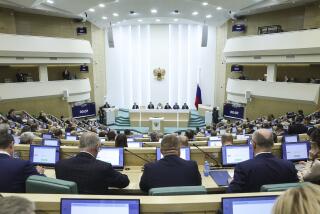U.S., Soviets Begin Talks on Monitoring of A-Tests
- Share via
GENEVA — The United States and the Soviet Union opened formal negotiations here Monday aimed at working out a system of seismic stations and on-site inspection to monitor nuclear testing under the partial and still unratified test ban treaties of 1974 and 1977.
The negotiations are expected to last two weeks and are regarded by the Soviets as a first step toward what Igor Palenykh, a member of the Soviet delegation, said would be “limitation and eventual cessation of nuclear testing.”
U.S. Ambassador Robert B. Barker said only that “our highest priority remains effective verification measures (that will) permit ratification of the two treaties.”
The 1974 treaty puts a limit of 150 kilotons on the yield of any underground nuclear explosion, and the 1977 treaty puts limits on nuclear explosions for peaceful purposes, as distinct from weapons testing. Above-ground nuclear tests are prohibited under an agreement signed in 1963 by President John F. Kennedy and Soviet leader Nikita S. Khrushchev.
No Verification Provisions
The United States has not ratified the 1974 and 1977 treaties because they contain no provisions for reliable verification. At the initiative of Soviet leader Mikhail S. Gorbachev, who has made a clear offer to open Soviet territory to monitoring and inspection, the present round of talks was agreed to by Secretary of State George P. Shultz and Soviet Foreign Minister Eduard A. Shevardnadze when they met in Washington in September.
There have been six Soviet-American meetings at the experts level in the last three years, to exchange information on seismic systems and possible verification procedures, but this is the first effort by the two sides actually to negotiate an agreement. The results of the first two weeks of talks will be reviewed at the meeting Reagan and Gorbachev have scheduled for next month in Washington.
Palenykh, the Soviet delegate to the talks here, said he hopes for agreement “as soon as possible, desirably in the first half of 1988.” This would enable Reagan to sign another arms control agreement on his projected visit to Moscow in the coming year.
Sticks to Present Treaties
While the Soviets continue to push for limitations and the eventual elimination of nuclear tests, the United States is prepared to go only as far as a verification system and ratification of the present treaties. The United States did propose, in the course of the negotiations on the 1977 treaty, a limit of five to eight underground tests a year for each side, but this was never taken up by the Soviets and is unlikely to be offered again, at least by the Reagan Administration.
Barker, in commenting on the present round of talks, avoided any mention of a further reduction, either in terms of yield or in the number of tests. Clearly these matters are to be left until after seismic systems have been installed in both countries to monitor and transmit data on underground explosions, and after on-site inspection procedures have been set up to look into anything outside the normal range.
More to Read
Sign up for Essential California
The most important California stories and recommendations in your inbox every morning.
You may occasionally receive promotional content from the Los Angeles Times.










